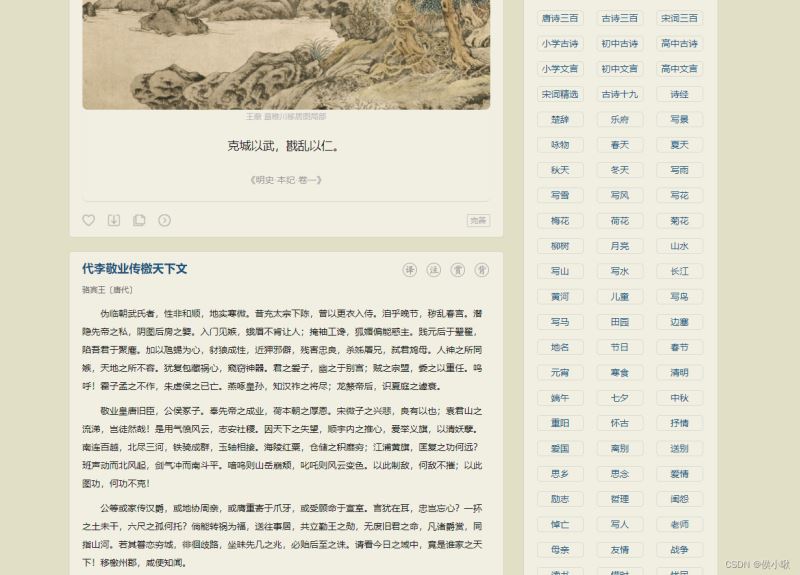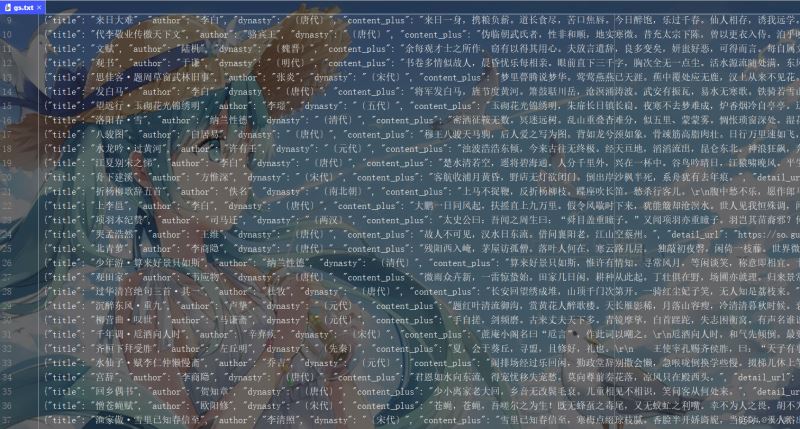通过python,Scrapy框架,爬取古诗文网上的诗词数据,具体包括诗词的标题信息,作者,朝代,诗词内容,及译文。爬取过程需要逐页爬取,共4页。第一页的url为(https://www.gushiwen.cn/default_1.aspx)。

首先创建Scrapy项目及爬虫程序
在目标目录下,创建一个名为prose的项目:
scrapy startproject prose
进入项目目录下,然后创建一个名为gs的爬虫程序,爬取范围为 gushiwen.cn
cd prose scrapy genspider gs gushiwen.cn
对配置文件settings.py做如下编辑:
①选择不遵守robots协议
②下载间隙设置为1
③并添加请求头,启用管道
④此外设置打印等级:LOG_LEVEL=“WARNING”
具体如下:
# Scrapy settings for prose project
#
# For simplicity, this file contains only settings considered important or
# commonly used. You can find more settings consulting the documentation:
#
# https://docs.scrapy.org/en/latest/topics/settings.html
# https://docs.scrapy.org/en/latest/topics/downloader-middleware.html
# https://docs.scrapy.org/en/latest/topics/spider-middleware.html
BOT_NAME = 'prose'
SPIDER_MODULES = ['prose.spiders']
NEWSPIDER_MODULE = 'prose.spiders'
LOG_LEVEL = "WARNING"
# Crawl responsibly by identifying yourself (and your website) on the user-agent
#USER_AGENT = 'prose (+http://www.yourdomain.com)'
# Obey robots.txt rules
ROBOTSTXT_OBEY = False
# Configure maximum concurrent requests performed by Scrapy (default: 16)
#CONCURRENT_REQUESTS = 32
# Configure a delay for requests for the same website (default: 0)
# See https://docs.scrapy.org/en/latest/topics/settings.html#download-delay
# See also autothrottle settings and docs
DOWNLOAD_DELAY = 1
# The download delay setting will honor only one of:
#CONCURRENT_REQUESTS_PER_DOMAIN = 16
#CONCURRENT_REQUESTS_PER_IP = 16
# Disable cookies (enabled by default)
#COOKIES_ENABLED = False
# Disable Telnet Console (enabled by default)
#TELNETCONSOLE_ENABLED = False
# Override the default request headers:
DEFAULT_REQUEST_HEADERS = {
'user-agent': 'Mozilla/5.0 (Windows NT 10.0; Win64; x64) AppleWebKit/537.36 (KHTML, like Gecko) Chrome/97.0.4692.71 Safari/537.36',
'Accept': 'text/html,application/xhtml+xml,application/xml;q=0.9,*/*;q=0.8',
'Accept-Language': 'en',
}
# Enable or disable spider middlewares
# See https://docs.scrapy.org/en/latest/topics/spider-middleware.html
#SPIDER_MIDDLEWARES = {
# 'prose.middlewares.ProseSpiderMiddleware': 543,
#}
# Enable or disable downloader middlewares
# See https://docs.scrapy.org/en/latest/topics/downloader-middleware.html
#DOWNLOADER_MIDDLEWARES = {
# 'prose.middlewares.ProseDownloaderMiddleware': 543,
#}
# Enable or disable extensions
# See https://docs.scrapy.org/en/latest/topics/extensions.html
#EXTENSIONS = {
# 'scrapy.extensions.telnet.TelnetConsole': None,
#}
# Configure item pipelines
# See https://docs.scrapy.org/en/latest/topics/item-pipeline.html
ITEM_PIPELINES = {
'prose.pipelines.ProsePipeline': 300,
}
# Enable and configure the AutoThrottle extension (disabled by default)
# See https://docs.scrapy.org/en/latest/topics/autothrottle.html
#AUTOTHROTTLE_ENABLED = True
# The initial download delay
#AUTOTHROTTLE_START_DELAY = 5
# The maximum download delay to be set in case of high latencies
#AUTOTHROTTLE_MAX_DELAY = 60
# The average number of requests Scrapy should be sending in parallel to
# each remote server
#AUTOTHROTTLE_TARGET_CONCURRENCY = 1.0
# Enable showing throttling stats for every response received:
#AUTOTHROTTLE_DEBUG = False
# Enable and configure HTTP caching (disabled by default)
# See https://docs.scrapy.org/en/latest/topics/downloader-middleware.html#httpcache-middleware-settings
#HTTPCACHE_ENABLED = True
#HTTPCACHE_EXPIRATION_SECS = 0
#HTTPCACHE_DIR = 'httpcache'
#HTTPCACHE_IGNORE_HTTP_CODES = []
#HTTPCACHE_STORAGE = 'scrapy.extensions.httpcache.FilesystemCacheStorage'
首先是进行页面分析,这里不再赘述该过程。
这部分代码,也即需要编辑的核心部分。
首先是要把初始URL加以修改,修改为要爬取的界面的第一页,而非古诗文网的首页。
需求:我们要爬取的内容包括:诗词的标题信息,作者,朝代,诗词内容,及译文。爬取过程需要逐页爬取。
其中,标题信息,作者,朝代,诗词内容,及译文都存在于同一个<div>标签中。
为了体现两种不同的操作方式,
标题信息,作者,朝代,诗词内容 四项,我们使用一种方法获取。并在该for循环中使用到一个异常处理语句(try…except…)来避免取到空值时使用索引导致的报错;
对于译文,我们额外定义一个parse_detail函数,并在scrapy.Request()中传入其,来获取。
关于翻页,我们的思路是:遍历获取完每一页需要的数据后(即一大轮循环结束后),从当前页面上获取下一页的链接,然后判断获取到的链接是否为空。如若不为空则表示获取到了,则再一次使用scrapy.Requests()方法,传入该链接,并再次调用parse函数。如果为空,则表明这已经是最后一页了,程序就会在此处结束。
具体代码如下:
import scrapy
from prose.items import ProseItem
class GsSpider(scrapy.Spider):
name = 'gs'
allowed_domains = ['gushiwen.cn']
start_urls = ['https://www.gushiwen.cn/default_1.aspx']
# 解析列表页面
def parse(self, response):
# 一个class="sons"对应的是一首诗
div_list = response.xpath('//div[@class="left"]/div[@class="sons"]')
for div in div_list:
try:
# 提取诗词标题信息
title = div.xpath('.//b/text()').get()
# 提取作者和朝代
source = div.xpath('.//p[@class="source"]/a/text()').getall()
# 作者
# replace
author = source[0]
# 朝代
dynasty = source[1]
content_list = div.xpath('.//div[@class="contson"]//text()').getall()
content_plus = ''.join(content_list).strip()
# 拿到诗词详情页面的url
detail_url = div.xpath('.//p/a/@href').get()
item = ProseItem(title=title, author=author, dynasty=dynasty, content_plus=content_plus, detail_url=detail_url)
# print(item)
yield scrapy.Request(
url=detail_url,
callback=self.parse_detail,
meta={'prose_item': item}
)
except:
pass
next_url = response.xpath('//a[@id="amore"]/@href').get()
if next_url:
print(next_url)
yield scrapy.Request(
url=next_url,
callback=self.parse
)
# 用于解析详情页面
def parse_detail(self, response):
item = response.meta.get('prose_item')
translation = response.xpath('//div[@class="sons"]/div[@class="contyishang"]/p//text()').getall()
item['translation'] = ''.join(translation).strip()
# print(item)
yield item
pass
在这里定义了ProseItem类,以便在上边的爬虫程序中调用。(此外要注意的是,爬虫程序中导入了该模块,有必要时需要将合适的文件夹标记为根目录。)
import scrapy
class ProseItem(scrapy.Item):
# define the fields for your item here like:
# name = scrapy.Field()
# 标题
title = scrapy.Field()
# 作者
author = scrapy.Field()
# 朝代
dynasty = scrapy.Field()
# 诗词内容
content_plus = scrapy.Field()
# 详情页面的url
detail_url = scrapy.Field()
# 译文
translation = scrapy.Field()
pass
管道,在这里编辑数据存储的过程。
from itemadapter import ItemAdapter
import json
class ProsePipeline:
def __init__(self):
self.f = open('gs.txt', 'w', encoding='utf-8')
def process_item(self, item, spider):
# 将item先转化为字典, 再转化为 json类型的字符串
item_json = json.dumps(dict(item), ensure_ascii=False)
self.f.write(item_json + '\n')
return item
def close_spider(self, spider):
self.f.close()
定义一个执行命令的程序。
from scrapy import cmdline
cmdline.execute('scrapy crawl gs'.split())
程序执行效果如下:

我们需要的数据,被保存在了一个名为gs.txt的文本文件中了。